Rodan
Our rating: four LAVA® motion lamps.
After some obligatory stock footage of nuclear explosions and some expository voice-overs for the benefit of stupid American audiences, the movie opens in the Japanese mining town of Kitamatsu. When the deepest shaft floods, trapping several miners, the mining company brings in Safety Inspector Shigeru, a.k.a. the Homer Simpson of Japan -- although, to be fair, Shigeru is much more earnest and sincere than Homer could ever be. After determining that the flooded shaft is filled with water, Shigeru finds something not usually found in mining shafts this side of My Bloody Valentine: a mutilated corpse. A murderer is suspected, and suspicion falls on Goro, who happens to be the brother of Shigeru's fiancee, Kiyo.
Some time later Shigeru is found alive in the mine, but he has totally lost his memory. Meanwhile, a high speed UFO is terrorizing the Pacific Rim. The UFO travels too high and too fast for anyone to get a look at it, but it is destroying planes and ships all over the place. An experience with some hatching bird eggs restores Shigeru's memory and he relives his experience in the cave: he was present at the hatching of a giant pteranadon egg! We're supposed to believe that the trauma of witnessing Rodan's birth caused Shigeru's amnesia; more likely it was the shame at running like a coward at the sight of Big Bird. Ok, maybe baby Rodan isn't exactly like Big Bird, but he's pretty darn close. Sure, we might not hang around for long after the appearance of a thirty-foot tall Baby Huey impersonator, but we'd certainly retain the memory of the event.
It is soon determined that the Rodans are hanging around Mount Toya ("My name is Mount Toya, you killed my father, prepare to die!"), so the Japanese military, which apparently employs not a single person who did the childhood experiment that involves a hornet's nest and a stick, decides to bomb the giant monsters with some light artillery. As one might expect, the two monsters fly out of the mountain, mad as hell. They head to the city of Saseba (Fukaoka in the original Japanese version) for some light afternoon stomping.
Rodan isn't a particularly deep movie, with little of the subtext that Godzilla (1954) had, despite some stock footage of the nuclear bomb tests at the very beginning. In fact, we were a little confused at the preachy anti-nuclear sentiment when Rodan is not, in fact, radioactive at all. Sure, the atomic tests caused the earthquakes that set free the monsters, but the monsters might as easily have been uncovered by the town's strip-mining. Still, the overly long English introduction allows for lots of recycled minutes of mushroom clouds and other devastation, which must have been worth something in 1956.
"As Kiyo-chan turned to weep on my shoulder, I realized the Rodans were doomed ... Like moths in those rivers of fire they seemed almost to welcome the agonies of death... The last of their kind, masters of the air and earth, the strongest, swiftest creatures that ever breathed, now they sank against the earth like weary children. They were dying together. I wondered if I, a 20th century man, could ever hope to die as well." Is it just us, or does it sound like they somehow got T.S. Eliot to write this speech? Rodan would go on to become a regular monster in the Godzilla mythology, even being resurrected for the Heisei series of films. Perhaps more surprising, Toho recently announced that they're bring back the Meganuron to be Godzilla's opponent in Godzilla 2001. It proves that even a small role can lead to big roles later on -- 45 years later in this case.
* Almost certainly this name is derived from Meganeura, an extinct genus of giant dragonflies. Go back!
** The original Japanese name (Radon) certainly derives from the name pteradon, an apparently incorrect alternate name for a pteranodon. Before the film reached US shores the monster's name became Rodan. Go back!
|

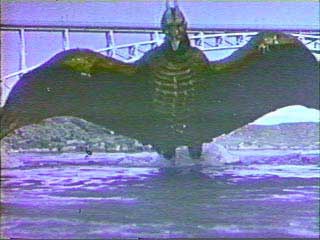
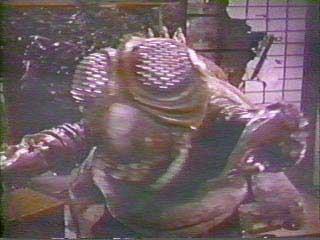
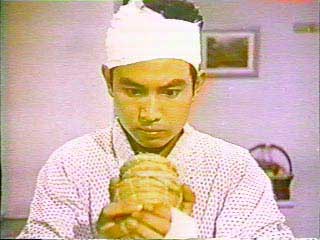
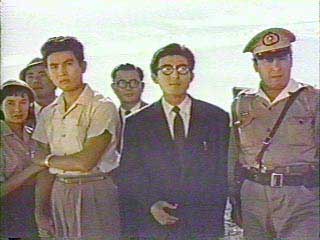
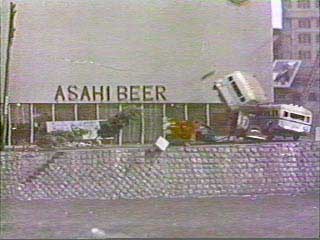


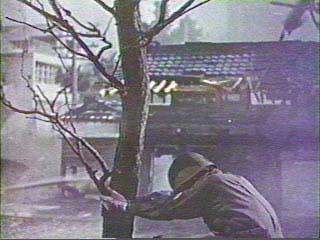 * "Every time Rodan shows up I happen to be next to this tree!"
* "Every time Rodan shows up I happen to be next to this tree!"